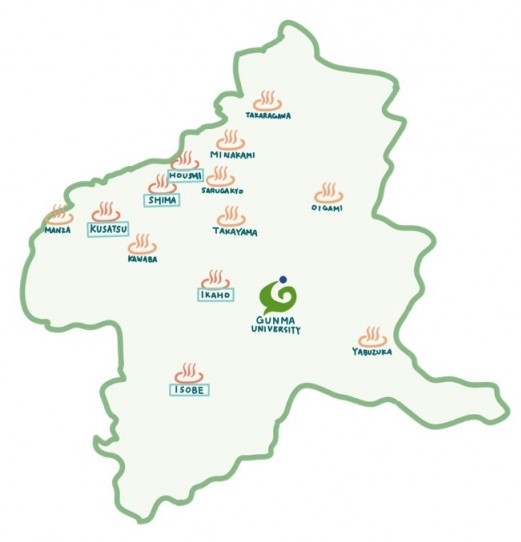
Integrated
Human Practices
OVERVIEW
The purpose of this project is to support our local onsen facilities. In order to understand the actual problems the facilities face frequently, we believe it is important to listen to the voices of those who work at the front line of onsen. We conducted an interview with staff of two onsen facilities, and were allowed to tour the facilities and see feed-water and drainage equipment of onsen. Furthermore, we went to onsen facilities in Gunma to collect samples of onsen water, which were used for preparation of our laboratory model biofilm. The results of our experiments indicated that a certain onsen water facilitated biofilm formation by far most efficiently. This information will be useful to the faculties located in the onsen area in terms of countermeasures against biofilms. We believe that the human practices have been well integrated among people of the onsen facilities, our experiments and our iGEM activities.
I. Human Practice
Interviews
Upon deciding on the theme, we started by interviewing actual onsen facilities to understand what real problems the facilities faced frequently. We interviewed managers in two onsen facilities in Gunma Prefecture that had bath water circulators. Also, we were allowed to tour the facilities and see feed-water and drainage equipment.
We were told that they always used chlorine-based antimicrobial reagents to sterilize hot water. Apparently, annual use of the reagents is seemingly so large in quantity even in one facility. Although we could not observe biofilms in pipes or bathtubs because of safety hazards or the facility’s reasons, they said that there were some problems attributed to biofilms in onsen, as below.
Problems:
- Biofilms are particularly observed in places in which clear water bubbles up, rocks around an outdoor hot spring or outlets of spring water.
- Biofilms are often a house of pathogens, and may be dangerous to not only consumers but also working staff.
- Biofilms make it quite difficult to clean up bathtubs or washing places with an ordinary detergent or disinfectant. Consequently, they have to use a stronger detergent or disinfectant, which is not always good for the environment.
- Biofilms increase pipe corrosion, certainly decreasing pipe life. Note that pipes used in the facilities are prone to rust due to specific compositions of onsen water.
Addressing these problems would lead to a variety of benefits to people in the facilities, customers and the environment in the real world.


II. Integrated Human Practice
Collections of samples of onsen water
It was not until we interviewed that we obtained special information about the effects of disinfectants. We were told that in some onsen water, the normal amount of disinfectants was totally ineffective, probably because disinfectants underwent reaction with something other than microorganisms in the onsen water. This means that the effects of disinfectants differ among kinds of onsen. Presumably, the effects of disinfectants considerably depend on components of onsen water such as minerals, ions (pH), organic matter and so on. This information also suggests that types of components of onsen water or types of onsen have various effects on biofilm formation. To make model biofilms more realistic, we tried to visit onsen facilities in Gunma to collect samples of onsen water (see in detail as below). Finally, we obtained five samples of onsen water, which were used in experiments for the formation of model biofilms. In fact, the results showed that efficiencies of biofilm formation differed among five onsen. Particularly, a certain onsen water was found to facilitate biofilm formation by far most efficiently. This information will be useful to the faculties located in the onsen area in terms of countermeasures against biofilms.
We believe that the human practices have been well integrated among people of the onsen facilities, our experiments and our iGEM activities.

Fig. 1 Storage Tank

Fig. 2 Special disinfectants used in onsen facilities
Acknowledgements
We all thank two famous onsen facilities, Minakami-kan and Megumi-no-Yu, for their kind cooperation.
Onsen places from which we obtained each bath water sample
To make the conditions of the model biofilms closer to the ones in onsen, we planned to create a culture using water collected from our local onsen. Below is the map of familiar onsen spots in Gunma prefecture.

We collected samples of onsen water from Kusatsu, Shima, Houshi, Ikaho, and Isobe. For the first four springs, water was collected from the public onsen spring head. For Isobe, the staff from Megumi no Yu kindly collected the onsen water from the storage tank of the facility. Each hot spring has its unique mineral compositions and has different pH, so we conducted a preliminary experiment to determine which combination of onsen and E.coli strain produces biofilm most efficiently. The details of the experiments are shown in the “Proof of Concept” section.
Characteristics of onsen water in different locations
| Onsen | pH | Spring Quality (most abundant minerals) | Temp. [°C] |
|---|---|---|---|
| Kusatsu (Watanoyu, Bandai) | 2.1 | S-Al-SO4・Cl | 51.3 |
| Shima | 7.4 | Na・Ca-Cl・SO4 | 50.1 |
| Ho-shi | 8.5 | Ca・Na-SO4 | 40.8 |
| Ikaho | 5.9 | Simple Onsen(defined as onsen with mineral content less than 1,000 mg/L) | 34.2 |
| Isobe | 7.3 | Na-Cl・HCO3 | 50.8 |





References
- Takuya Koguchi. (2019).Yubatake: The Famous Symbol of Kusatsu Hot Springs https://www.google.com/url?q=https://www.fun-japan.jp/en/articles/10824&sa=D&source=docs&ust=1634752924242000&usg=AOvVaw2K2fMw3voF-vLbmdAOJyDo
- Miki Tajima. (2013). Hot spring composition analysis https://www.google.com/url?q=https://www.hotelvillage.co.jp/shared/img/onsen-yubatake.pdf&sa=D&source=docs&ust=1634752924243000&usg=AOvVaw2EKiQxwuvpmJZFzhsh0LWK>https://www.google.com/url?q=https://www.hotelvillage.co.jp/shared/img/onsen-yubatake.pdf&sa=D&source=docs&ust=1634752924243000&usg=AOvVaw2EKiQxwuvpmJZFzhsh0LWK
- General incorporated association,Shima Onsen Association.(2020).History and Present of Shima https://www.google.com/url?q=https://nakanojo-kanko.jp/shima/appeal/history/&sa=D&source=docs&ust=1634752924243000&usg=AOvVaw2xrInoCRXrqYtJi0B3rY8e
- Gugutto Gunma Tourism Promotion Council.(2021).[Spring quality] Smooth and gentle - simple hot spring https://www.google.com/url?q=https://gunma-dc.net/feature/type01/&sa=D&source=docs&ust=1634752924242000&usg=AOvVaw1LD6Y3oFKzJbTJ_vMn36RA
- Japan Onsen Association Onsen masters.(2021).Hot Springs Introduction, Isobe Onsen https://www.google.com/url?q=https://www.spa.or.jp/search_p/detail_p/?F_ID%3D100510%26pg%3D0&sa=D&source=docs&ust=1634752924241000&usg=AOvVaw36OaHWmNueaRsMOrAKDgKE
